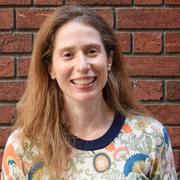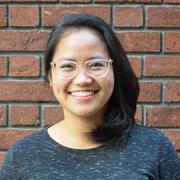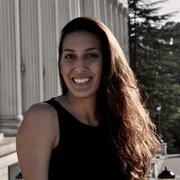In Hackbright Academy’s immersive and rigorous 12-week full-time Software Engineering Program, students not only learn the skills to become engineers, but build impressive web apps in weeks. Learn more about these amazing women in their own words and get a glimpse into the wide variety of apps they built this cohort, each showcasing our newly-minted grads’ unique interests and personalities.
Ada Cohort: June 2018

Amanda Barker
Amanda is excited to use software engineering to improve lives in unusual ways. Having a geography (GIS), water resource management, and engineering background, she hopes to shape systems in pursuit of the common good. She became interested in software engineering after teaching physics and doing mechanical research at the undergraduate level, and her internship in the public engineering sector built her experience in public-private partnership. She loves effective communication of data (especially spatial); what use is data without interpretation? Service is a strong driver for her; community pursuits like Girl Scouts and music education outreach have always been a part of her life. Her hobbies include archery, textile arts, and hiking.
Hackbright Project: Music Class
Music Class is an educational tool designed for music educators to enrich student learning with “game-ification” and implement music specific assignments on a classroom scale. Features include an extensive classroom database system, an instrument inventory system, classical music listening assignments, interactive d3 charts tracking student progress and educating about composers, interactive JS tools to assist student practicing, JS sight reading games, and JS scale testing using the HTML audio extension. Using this app has the potential to same teachers weeks of classroom time and motivate students to excel through competition with their peers.
Technology Stack:
SQL Alchemy, Flask, JavaScript, Python, VexFlow, HTML audio, d3, jQuery, Ajax, Jinja2, XLSXwriter, Werkzeug uploader, CSS, Bootstrap
APIs Used:
Wikipedia, Youtube
C.S. or Related Experience Prior to Hackbright:
Amanda worked with GIS, creating maps and as-builds during her engineering internship with the South Coast Water District, and on a freelance basis. She performed 2 years of undergraduate research using machine learning models, technical writing, 3D mesh models, and aerodynamic simulation. She also taught physics labs for 3 years, communicating calculus-based scientific concepts to students with the goal of building core understanding.

Amee Li
Amee studied her passions of economics and psychology in university, and came to Hackbright after working in the automotive industry with over 70 vendors as an accounts manager. Her role required optimizing departments budgets and acquiring new clients through data-driven decision-making. Compelled by a curiosity to understand the engine behind data processing, Amee began learning to code in her free time. This sparked a love for building solutions and fueled her pursuit of a full programming education. She loves tackling novel programming challenges, especially those in web design and data visualization. Amee hopes to combine her business acumen and programming capabilities to build future software solutions from the ground up.
Hackbright Project: Wanda
Wanda is a mindfulness tracker focused on improving a user’s overall happiness and well-being. It is inspired by a recent study by Harvard professor Daniel Gilbert, which revealed that humans mind-wander (think about something other than what they’re doing) nearly half of the time, and are significantly less happy when doing so. Wanda reminds users to focus on the present and gathers mind wandering and happiness data through text surveys sent throughout the day. The data is then used to create charts for the user to visualize the impact that mind wandering has on happiness with the goal of decreasing this habit over time.
Technology Stack:
Python, JavaScript, D3 , Flask, PostgreSQL, Jinja
APIs Used:
Twilio
C.S. or Related Experience Prior to Hackbright:
Amee self studied coding by using resources like Codecademy and Udacity. She also read Eloquent JavaScript and concurrently took the JavaScript Hack Reactor prep course.

Ashley Freidel
Before Hackbright, Ashley earned her Doctorate in Chiropractic Medicine and was in the medical field as a Chiropractor, running day to day logistics of being in clinic and managing patients. Prior to that, Ashley ran a Chiropractic practice in Downers Grove, IL as an office manager where she was in charge of everything from hiring new staff to billing and working with insurance companies. While Ashley enjoyed that work, she was ready for a change and decided to pursue software engineering due to her passion for problem solving and creativity.
Hackbright Project: Glutie
Glutie is a search engine used to find restaurants in San Francisco that specifically have gluten-free options on their menu. There is also the option to find gluten-free bakeries, coffee shops or bars. The site is designed with simplicity in mind and has an easy to navigate UI. The site can be used without the user registering for an account. If the user is registered, they have the option of storing their favorites. Users can search by location, price and if the restaurant is currently open through custom algorithms. Search results include information about the restaurant, displaying contact information, hours of operation and Yelp ratings via Yelp API. The user can see the exact location of the restaurant of choice via Google Maps API.
Technology Stack:
Python, Flask, Jinja, JavaScript, AJAX, JSON, SQLAlchemy, PostgreSQL, jQuery, HTML, CSS, Bootstrap
APIs Used:
Yelp, Google Maps
C.S. or Related Experience Prior to Hackbright:
Prior to enrolling in the full-time engineering program at Hackbright, Ashley took online courses at edX and Codecademy, where she first learned Python and the command line. Ashley read Automate the Boring Stuff with Python by Al Sweigart and navigated through the online version of How to Think Like a Computer Scientist. She completed the Prep Course at Hackbright in February 2018 where she built her first text-based game in Python.
Benish Sarinelli
Benish worked as a technical project manager since 2014 at Zenefits in San Francisco. Prior to working at Zenefits, Benish completed her B.S in Business Information Systems at San Francisco State University. Initially interested in product management, she quickly discovered a passion for software engineering. She was also a subject matter expert in areas of product. In addition to her role as TPM, she took on solutions engineering, working cross-functionally to develop a deep understanding of what product gaps existed in partnership with sales colleagues. Benish is excited to begin a new career as a software engineer doing what she loves most: building products to make people’s lives easier!
Hackbright Project: Travel:list
Travel:list allows a user to create trips to store activities and recommendations. The Google Maps and Geocoding API ‘s work together to allow users to visually track upcoming trips. Users can create, update, add, and delete both activities and trips as needed.
Technology Stack:
Python, AJAX, jQuery, JavaScript, Flask, PostgreSQL
APIs Used:
Google Maps API and Google Geocode API
C.S. or Related Experience Prior to Hackbright:
B.S. in Information Systems and Business Administration and from San Francisco State University. Worked as Technical Project Manager at Zenefits since 2014. Completed courses at General Assembly in SQL, HTML/CSS, and Data Analytics. Hackbright Prep February 2018.

Denise Dekker
Before returning to complete her degree at Mills College, Denise worked as a buyer and logistics coordinator for an organic produce distributor. While taking a beginner programming class in Python, she became enamored with coding, took a leap of faith, and changed her major to Computer Science. Denise believes that everyone should have exceptional experiences with web and mobile technologies. She is passionate about the convergence of design, accessibility, user experience, and developing elegant solutions that are user-focused and data driven. When not writing code, Denise is an avid chef, produce geek, kombucha brewer, and sometime DJ for fundraising events at her daughter’s school.
Hackbright Project: SHERO
As a new engineer entering the workplace, Denise built an app called Shero: a mentoring website for women engineers. She’s passionate about changing the ratio of female engineers and women in technical roles lifting each other up. Her app is a place where women can find a mentor, or mentor others, and find events to meet other women in tech regardless of experience.
Technology Stack:
Flask, Python, SQLAlchemy, Ajax, Bootstrap
APIs Used:
Eventbrite
C.S. or Related Experience Prior to Hackbright:
Denise has dabbled in various languages and frameworks, such as Ruby, Python, Java, JavaScript (jQuery, JSON), HTML, CSS, HAML, Jade, Ruby on Rails, MEAN stack, Android Studio, UX design/methodology, Bootstrap, Flask, and React. Most recently, she freelanced as a web developer and interned at a non-profit redesigning and improving a mobile app’s UI, accessibility, and usability.

Dorothy Bee Geiger
Dororthy Bee is a true Jane of all trades. She is an accomplished archaeologist with over ten years of field and lab experience and for more than two years, she was the band leader of a successful New Orleans-style Brass band in New Orleans. Since completing her Masters in Anthropology, she has worked as a professional tailor/designer, queer/trans community organizer, and Karaoke Jockey. Dorothy Bee incorporated numerous technologies into all these jobs and always found joy in encountering new challenges which required innovative creative solutions. She finds the same joy in always trying, failing, learning, and succeeding at new things in programming and hopes to develop this joy for learning into a job as a software engineer.
Hackbright Project: SafeWork
In the wake of recent laws and policies that have taken down numerous sex work websites, sex workers have had fewer and fewer safe avenues to make money. Safework is a web app designed to provide support, advice, and added safety for sex workers. It includes a series of Reddit-like forums and a map of all of the recent prostitution arrests in supported cities. The forums are designed to serve and support sex workers in a myriad of intersectional topics. The map collects published police data of sex work arrests so that local workers are aware of potential dangers from local law enforcement.
Technology Stack:
Python, JavaScript (AJAX, JSON), HTML, CSS, SQL, Flask, jQuery, Bootstrap, Jinja, PostgreSQL, SQLAlchemy
APIs Used:
Google Maps, DataSF, Socrata
C.S. or Related Experience Prior to Hackbright:
Throughout her career, Bee has encountered numerous software packages and created professional work and presentations from the Adobe Suite to ESRI ArcGIS to ProTools to a myriad of statistical software. As a graduate student, she studied HTML and CSS in order to create her lab’s website. She also studied extended applications of ArcGIS by coding macros to help find and highlight patterns in maps of historic and prehistoric landscapes.

Hae-in Lim
Hae-in started learning to code as a creative outlet (her first creation was a pigeon Twitter bot). Before Hackbright, she worked in marketing and business development at Teespring, an e-commerce startup, where she led the creator business, comprising one-third of company revenue. Previously, she worked at think tanks in Washington, DC, conducting research on tech policy, privacy, and corporate social responsibility. As a lifelong learner, Hae-in is excited to immerse herself in a new field, learn C as her third programming language, and build more Twitter bots. She has a BA in African Studies from Yale and an MA in International Relations and Economics from the School of Advanced International Studies (SAIS) at Johns Hopkins.
Hackbright Project: YouTube Data Collective
The YouTube Data Collective (YTDC) crowdsources information about YouTube video demonetization, allowing creators to gain third-party visibility into how YouTube’s policies are implemented. When users submit new data, YTDC supplements it with data from the YouTube API and image and sentiment analyses from the Clarifai and Google NLP APIs. YTDC has a custom search engine based on an inverted index where postings are stored in a linked list; results are ranked through tf–idf. D3’s Force layout visualizes connections among videos, drawing from an undirected graph implemented with an adjacency list. Another chart allows users to compare video tags and uses a trie for autocomplete. YTDC launched with a seed data set of over 30,000 videos.
Technology Stack:
Python, JavaScript, jQuery, Flask, Jinja, SQLAlchemy, PostgreSQL, D3, Chart.js, Bootstrap, HTML/CSS, Natural Language Toolkit (NLTK)
APIs Used:
YouTube Data API, Clarifai API, Google Cloud Natural Language API
C.S. or Related Experience Prior to Hackbright:
Hae-in fell in love with Python while taking MIT’s introductory computer science course (6.00.1x) on edX. At Teespring, she learned SQL in order to independently conduct marketing and business analyses and taught other Teespring employees as well. She gained a working knowledge of HTML and CSS in college, which came in handy for marketing activities like conducting Optimizely tests and building landing pages.

Isabella Applen
After graduating from Mills College, Isabella worked at a middle school in Oakland through AmeriCorps. She ran an after-school class, implementing individualized programs to improve the math and reading skills of at-risk students. Next, Isabella worked as a behavioral therapist with autistic children, doing one-on-one sessions with clients. This involved teaching new skills, reshaping behavior, and recording meticulous data. Outside of work, Isabella began studying programming out of intellectual curiosity and a desire to build tools she wanted to use. Isabella then shifted to doing freelance work, allowing her time to delve deeper into programming and build the necessary skills to attend Hackbright.
Hackbright Project: Track Well
TrackWell takes daily input from users and conducts linear regression analyses to determine the correlative strengths between a user’s behaviors and sense of well-being. These correlative insights are expressed through polynomial graphs and declarative statements like, “Out of all the activities you are tracking, X is the most relevant to your sense of well-being. The more/less X you get, the better you tend to feel that day.” TrackWell also examines the relationship between behavior and next day sense of well-being (“The more X you get, the better you tend to feel the next day”). TrackWell has users to record their hours of sleep, screen-time, and exercise, but the user can also design their own independent variables they’d like to track.
Technology Stack:
Python, Jinja, JavaScript, Jquery, Highcharts
C.S. or Related Experience Prior to Hackbright:
Prior to attending Hackbright, Isabella learned Python fundamentals through Zed Shaw’s book, Learn Python the Hard Way. Isabella also took Codecademy courses in HTML, CSS, and Bootstrap.

Janet Chavez
Janet’s start in tech was a happy accident. From a Politics major to a Computer Science major, Janet graduated from the University of San Francisco with a BS in Computer Science and minors in Politics and Latin American Studies. While at USF, she established and dedicated her time to GirlTechPower, a program that taught middle and high school girls to code. She also volunteered as an instructor and loved experiencing the excitement in the classroom every week. After transitioning to a job in the retail industry, she has a knack for conflict management and interpersonal communication. She joined Hackbright excited to become a more robust full-stack web developer and carry on the same spirit for empowerment as GTP and Hackbright.
Hackbright Project: TrolliAm
TrolliAm uses machine learning to provide a label of either “troll” or “nontroll” for a tweet. After logging in through Twitter, the user can copy the link to the tweet they would like to test and receive the corresponding label. The classifier for TrolliAm is trained with the data of 200,000 confirmed Russian troll accounts and their tweets, believed to be managed by Russia’s Internet Agency. The TrolliAm app provides visualizations of the original dataset to illustrate how these Russian troll accounts may have influenced the 2016 Presidential election.
Technology Stack:
Bootstrap, Flask, JavaScript (AJAX, JSON), jQuery, NumPy, Pandas, PostgreSQL, Python, SciKit Learn
APIs Used:
C.S. or Related Experience Prior to Hackbright:
Janet has a BS in Computer Science from the University of San Francisco. While at USF, she was a tutor for the Computer Science department, helping students in both lower- and upper-level courses. Apart from her tutoring, she was also co-founder, Vice President, and eventually President of the Women in Computer Science club. Her favorite language to work in is Python, but she also has experience in Java, C, PHP, and JavaScript.

Jessica Koscheka
Jessica has a background in clinical nutrition, public health, and working with urban food insecurity. She worked as a clinical dietitian in the dynamic and fast-paced healthcare environment, interacting closely with teams of physicians, nurses, and other specialists. It was in this environment where she saw how advances in technology and automation were leading to major advances in healthcare by improving processes and ultimately, better outcomes for patients. Her desire to make a difference, coupled with a love for problem-solving, moved her to make the big leap forward into the field of computer engineering. Jessica holds an MS in Nutrition from Columbia University and a BA in Biology and Foreign Languages from University of Delaware.
Hackbright Project: Nutrify
While working as a clinical dietitian, Jessica saw firsthand that limited food options and meal plans were the biggest obstacles for patients to follow a restricted diet. She built Nutrify to help users find recipes based on diet restrictions and preferences, providing them with a multitude of options to meet their goals. The app uses Flask and the Edamam API to search for recipes based on nutrient quantity (low sodium, high protein, etc) and recipe ingredients. Users can save recipes and analyze the nutritional components of a recipe, as well as modify servings to understand how the quantity increases the amount of a nutrient in their diet. Nutrify uses Chart.js to visualize how the amount of a nutrient in a recipe impacts a user’s goal.
Technology Stack:
Python, Flask, Jinja, SQLAlchemy, JavaScript (AJAX, JSON, Chart.js, jQuery), HTML, CSS, Bootstrap
APIs Used:
Edamam API
C.S. or Related Experience Prior to Hackbright:
Jessica started to learn programming by taking courses on Coursera, Codecademy, and StackSocial. She taught herself basics of Ruby and completed code challenges on Codewars. Before joining Hackbright’s Software Engineering program she completed Hackbright Prep where she built multiple games, including a 9×9 Sudoku Game as her final project.

Karynn Ikeda
A former events and community manager, Karynn began her journey in tech five years ago working San Francisco conferences – Google I/O, Failcon, Lean Startup Week – and Meetups – SF New Tech, MobileMonday, PitchForce. Hackathons were next for Karynn. She organized hackathons across the country in San Francisco, New York, Seattle, Austin, and Atlanta, connecting developers with brands like Sears, Lowes, and Capital One. Inspired by the apps that developers created at her events, she decided to apply to Hackbright and become a software engineer.
Hackbright Project: Quippoll
Quippoll allows users to create, view, update, and delete their own polls to gather feedback from an audience. User input is collected via web form and SMS, using the Twilio API, and updated in realtime via WebSockets and React. User authentication is handled on the backend with Flask-Login while user permissions for each poll are managed on the frontend with React-Router.
Technology Stack:
Python, Flask, Flask-Login, Flask-Socketio, Jinja, Postgresql, SQLAlchemy, JavaScript, jQuery, Webpack, React, React-Router, SocketIO, Semiotic, Bootstrap, CSS/HTML
APIs Used:
Twilio
C.S. or Related Experience Prior to Hackbright:
A side interest since college at Brown University, coding became Karynn’s full-time endeavor in 2018. In addition to Python and JavaScript, she has prior experience deploying websites through WordPress and styling in HTML/CSS. Her favorite books for budding developers are How to Think Like a Computer Scientist and Grokking Algorithms: An illustrated guide for programmers.

Laura Christian
Laura fell into coding by accident, while working part-time in the legal department of a tech company to help pay her way through a doctoral program in the humanities at UC Santa Cruz. In an effort to improve the in-house-built contracts database she was managing, she began teaching herself SQL and principles of database architecture. She’s been hooked ever since. Following the completion of her PhD, Laura spent two years as an undergraduate humanities professor before finally returning to the world of database development. Between her academic and her technical pursuits, she combines an exceptional ability to communicate complex ideas clearly with a passion for identifying the right analytical framework to solve the question at hand.
Hackbright Project: Visualizing PhotoVoltaic Output
Using hyperlocal data gathered from DarkSky, a weather API, as well as Astral, a Python library for calculating the position of the sun, the app dynamically aggregates and renders kWhs generated by solar array in relation to historical cloud cover averages and daily/seasonal solar arcs.
Technology Stack:
Python, Flask, SQLAlchemy, Postgres, JQuery, AJAX, JSON, Chart.js
APIs Used:
DarkSky weather API
C.S. or Related Experience Prior to Hackbright:
Laura has 10 years of experience in database development and management. She loves helping clients get more out of their data by extracting and visualizing it in ways that make it more transparent, relevant and immediate.

Lauren Burwell
Always carving paths and embracing challenges, Lauren aspires to lead a life that is daring and unprecedented. Before pursuing a career in software engineering, she spent 3 years as a middle school math and science teacher. Her love for technology drove her to explore a different path. Lauren’s interest in coding peaked after attending an all-women Hackathon where she worked with a team whose product won “Best Solution to a Challenge.” Lauren was intrigued by the prospect of turning her ideas into products. Shortly thereafter, she enrolled in the Hackbright Prep Course. Now she is preparing for a career in software engineering, with an interest in security.
Hackbright Project: Healthy Poop
Healthy Poop is breaking the silence around a bodily function that is ubiquitous. With colon cancer on the rise in young people, this platform allows users to track their bowel frequency and stool types. Users create an account and select an image that most closely represents their poop. Before submitting, the user can also store additional notes for future reference. The data is timestamped and renders to a scatter plot using chart.js. The y-axis represents the 7 most common stool types and the x-axis displays when the data was entered.
Technology Stack:
Python, JavaScript (AJAX, JSON), HTML, CSS, PostgreSQL, Flask-SQLAlchemy, Jinja, Chart.js, Moment.js
C.S. or Related Experience Prior to Hackbright:
Before Hackbright, Lauren was entirely self-taught through online Udemy courses in JavaScript and Python. From there she completed the Hackbright Prep course before being accepted into the Full-Time Software Engineering Program.

Lauren Tweedie
Lauren received her Bachelors degree in physics from the College of Creative Studies honors program at University of California, Santa Barbara. During her time as an undergraduate she conducted interdisciplinary research within the Kavli Institute for Theoretical Physics, combining computation, physics, and biology to explore the properties of cells. After graduating, she worked as an Associate Technical Account Manager for Yardi Systems in Goleta, CA where she provided live technical support to hundreds of clients. Her passion for problem solving and taking on new challenges led her to Hackbright Academy where she expanded her technical computing knowledge in pursuit of a career in back-end infrastructure engineering.
Hackbright Project: Quip Pro
Quip Pro is a social word game based off the hit game Quiplash by Jackbox Games. Players join in on their devices using a randomized four-letter room code shared with them by the player hosting the game, and answer a set of prompts with short, silly, witty answers. Each prompt is answered by two different players, and once everyone has finished answering, the game moves to a voting round where players vote for their favorite answers to the prompts they didn’t answer. After everyone has voted on a prompt, the author of each answer is revealed, along with which players voted for which answer. Players receive points for the votes they receive, and the player with the most points at the end of the game wins.
Technology Stack:
Python, PostgreSQL, SQLAlchemy, Flask, Socket.IO, JavaScript, Redux, React
C.S. or Related Experience Prior to Hackbright:
Lauren’s prior tech experience comes from her background in computational physics research, using Python to build simulations of soft tissue networks in cells. Her work at Yardi Systems led her to gaining hands-on experience with SQL and kindled an interest in systems and database administration.

Margarita S. Noche
Before Hackbright, Margarita was a Special Education teacher in her home country of the Philippines. Working with autistic and physically disabled children, she showed creativity and dedication through her development of individualized programs for each student. After moving to the tech-centric Bay Area, she developed a curiosity for programming, which ultimately led to her fellowship with Hackbright Academy. Margarita is passionate about solving problems and learning, and is excited apply her software engineering skills and experience to create solutions that add value to people’s lives. When Margarita is not busy coding, she is typically found cuddling her Maltese puppy named Cotton or scheming during a game of Settlers of Catan.
Hackbright Project: Munch Buddy
Make a new friend today over a great meal! Munch Buddy is a web application that matches people who like similar foods. It utilizes the Yelp API to procure cuisine categories and restaurants. The app allows users to create an account, select cuisine preferences, and make a profile. Passwords are hashed before storing it in the database using Werkzeug, and profile pictures are uploadable using Flask-Uploads. Once signed up, Munch Buddy will pair users based on their Pearson’s correlation. The homepage displays matched users and features in-app, and live messaging with socket.io. Munch Buddy also makes restaurant recommendations, which can be saved using AJAX call. This display changes without having to reload the page.
Technology Stack:
Python, HTML, CSS, SQLAlchemy, Flask, Jinja, AJAX, jQuery, Bootstrap
APIs Used:
Yelp API
C.S. or Related Experience Prior to Hackbright:
Margarita has dabbled in HTML for customizing her Friendster profile in her early years. More recently, she completed Hack Reactor’s online prep course, and several courses in JavaScript and Python on Codecademy and Udacity.

Monica Smith
Monica graduated with a BS in Physics from the University of San Francisco in 2017. As an undergraduate she worked as a tutor in the Physics department, assisting other students in preparing for tests and solidifying their understanding of concepts. Monica liked sharing her technical knowledge with other students because she could connect with others over science. College was also where she first became fascinated with coding during a computer science course. Monica enjoys the programming thought process because it allows her to be both creative and analytical, engaging her scientific background. In her free time, Monica likes to hike, read, and spend time with friends and family.
Hackbright Project: Lightly
Lightly is a map routing application that optimizes routes based on the geolocations of streetlights. The goal is to provide the user a route with better nighttime visibility, making walking after dark a more comfortable experience. Lightly’s algorithm utilizes the Routeboxer library to determine the number of streetlights positioned within proximity of each route. Then it calculates the overall density of light locations, displaying the best-lit route to the user. Users are notified if the best-lit route is significantly longer than the shortest route, which they may choose to opt for instead. Dynamic login and register forms were created with React.
Technology Stack:
JavaScript, Python, PostgreSQL, SQLAlchemy, React, Flask, Jinja, jQuery with AJAX, Bootstrap, Routeboxer library
APIs Used:
Google Maps API
C.S. or Related Experience Prior to Hackbright:
Prior to Hackbright, Monica learned JavaScript through online courses and self-study in preparation for a bootcamp. Monica was first exposed to Python in an Introduction to CS course in college. She then used her knowledge of the language in an engineering internship at Samtec during her junior year of college, where she wrote Python script to automate hardware which collected data on the distribution of light passing through an electronic-photonic processor chip.

Na Ho
Na graduated from University of California, Santa Cruz with a degree in Legal Studies. Following graduation, Na dove into the legal field working at Latham & Watkins, where she applied logic and analytical skills to solve legal issues with her team. Her passion for problem solving and innovation led her to Hackbright Academy. As an avid problem solver, she felt it was important to gain the knowledge and power to create a solution using technology. After Hackbright, she is excited to build her skills as a full-stack software engineer and #changetheratio.
Hackbright Project: Foodio
Foodio is a web application that solves the problem of deciding what to cook for dinner. Foodio creates a virtual refrigerator that maintains food inventory and populates delicious recipes based on those ingredients. Users are able to add, remove, and update food quantities as ingredients are used. New recipes will generate based on food changes. Users can also save their favorite recipes.
Technology Stack:
Python, Flask, PostgreSQL, SQLAlchemy, JavaScript, jQuery, AJAX, HTML, Jinja
APIs Used:
Spoonacular
C.S. or Related Experience Prior to Hackbright:
Hackbright Prep Course

Octavia Payne
Octavia is a writer-turned-software engineer, who led communications for an open-source forest monitoring platform at an environmental think tank. Working with developers in her previous role was what first sparked Octavia’s passion for engineering. She was intrigued by the potential of good UX design combined with machine learning insights to tackle challenges ranging from tailoring restaurant recommendations to stopping deforestation. Octavia is looking to use her communications skills to become a full-stack developer with an eye for intuitive front-end design. Octavia earned her B.A. in Anthropology from the University of Pennsylvania and is a three-time national champion in Ultimate Frisbee.
Hackbright Project: tasteBud
A virtual friend that recommends restaurants that fit your taste. tasteBud predicts restaurants a user is likely to enjoy by calculating user-to-user and restaurant-to-restaurant similarity based on the user’s rating history.
Technology Stack:
Python, JavaScript, React, jQuery, Flask, Jinja, PostgreSQL, SQLAlchemy, HTML/CSS
APIs Used:
Yelp Fusion
C.S. or Related Experience Prior to Hackbright:
Octavia began studying Python, JavaScript, and HTML/CSS three years ago via courses through General Assembly, Coursera, and edX.

Sonya Salimy
Sonya’s interest in coding began with her education in the environmental sciences and public policy. She earned her bachelor’s degree from UC Berkeley in Society and Environment and her master’s degree from the University of Freiburg (Germany) in Renewable Energy Engineering and Management. Through her experiences interning for the federal government and working in the public sector, she realized that computer programs can more effectively analyze and optimize social and environmental services. Sonya plans to combine her love of problem solving and computer science skills to create applications for the common good.
Hackbright Project: EIStracker
EIStracker is a web application designed to better inform the public of Environmental Impact Statements (EISs) open for public commenting across the United States. It was created with the intention of generating awareness through the use of social media at the early stages of environmental reviews . The Google Maps API was used to display projects happening in each state, with project documents easily accessible for download upon a click. Users can tweet preloaded project details or generated a Facebook message with a link to the EPA’s EIS Database in order to raise awareness. A Twitter timeline displays the user’s tweets along with others using the same hashtag. All data was obtained from the EPA’s EIS Database via scraping.
Technology Stack:
Python, JavaScript (AJAX, JSON), PostgreSQL, Flask, SQLAlchemy, jQuery, Bootstrap, BeautifulSoup, HTML, CSS
APIs Used:
Google Maps, Twitter, Facebook
C.S. or Related Experience Prior to Hackbright:
Prior to participating in the Full-Time Software Engineering Program, Sonya completed the Hackbright Prep program and was introduced to SQL and Python in a master’s course on Energy Informatics.

Suriya Selvaraj
Suriya is interested in full-stack development and curious how every software product literally changes the way we eat, sleep, interact, and you name it. After graduating in Electronics and Communication Engineering, Suriya ran an institution for children with learning disabilities that offered a wide array of services including psychological counseling to parents, personalized curriculum for children, assigning/evaluating personal and group instructors, and more. She successfully led the company to an acquisition. She became curious about CS after seeing computers flying airplanes to delivering pizza, started exploring programming on her own, eventually leading to attending Hackbright.
Hackbright Project: SocialINPark
Being a mom, Suriya always wanted her kid to socialize with other kids, and for herself to know other moms to share things about their kids. Her app aims just to do that. It helps locate children’s park near the user, and also will give a comprehensive rating for the park. Users can leave ratings and also submit direct feedback to park curators. You can see when and where other kids are coming and can register to go during a popular time.
An ETL job extracts all park data from the government website and the UI uses Google Maps to visually show parks nearby. The app stores ratings, feedback, and the schedules of parents. These ratings are shared anonymously with other parents so that they can register and bring their kids during a popular time.
Technology Stack:
Python, JavaScript (AJAX, JSON), HTML, CSS,Flask, jQuery, Bootstrap, Jinja ,PostgreSQL, GitHub, iPython
APIs Used:
Google Map
C.S. or Related Experience Prior to Hackbright:
Suriya’s exposure to programming began during her undergraduate degree, learning fundamentals of C and MATLAB, a programming language to create embedded system models. As part of her undergraduate Capstone project, Suriya used MATLAB to work on AES (Advanced Encryption Standard) and proposed VLSI design – DCRAM (memory oriented architecture) and significantly improved speed and lowering cost. She also took Udacity’s Intro to JavaScript course.

Tieshia Francis
Tieshia is the first in her family to earn a Master’s Degree in Engineering and to direct an improvisational comedy troupe. Her past careers ranged from battery science to business development analysis. Her initial foray into coding used MATLAB to automate the statistical analysis of battery electrode images. Throughout all of her jobs, she found her favorite part of her work revolved around data organization and learning ways to automate routine tasks. This led her to pursue online courses in SQL and Python. Along the way, she discovered the field of software engineering, which married her love for logic with the creative and collaborative elements of improv. She looks forward to bringing those skills to a back-end engineering position.
Hackbright Project: Meal-of-Fortune
Meal-of-Fortune is a meal planning application that allows users to minimize food waste and to determine quickly what meals to make for the week. It generates meal plans based on the list of ingredients the user plans on cooking. When entered, the application creates various combinations of these ingredients and passes them to the Edamam API using a recipe diversification algorithm, providing the user a greater variety of recipes from which to choose. In addition, Meal-of-Fortune features a recipe recommendation engine that uses a series of SQLAlchemy queries to determine the best recipes based on user ratings, automatically suggesting meals to a user without their having to create a new meal plan.
Technology Stack:
PostgreSQL, Python, Flask, JavaScript, HTML/CSS
APIs Used:
Edamam
C.S. or Related Experience Prior to Hackbright:
Tieshia is familiar with Python, JavaScript, and SQL. She took Introduction to Computer Programming in grad school, where she first discovered writing code in MATLAB. She has also completed the following courses: Programming Foundations, Data Science Foundations, Learning Data Governance, Statistics Foundations 1, Introduction to R and Intermediate R, Learn SQL, SAS Programming 1, as well as completed miscellaneous work with Tableau, VBA, and GNUplot.

Tong Zhang
Before Hackbright, Tong worked as a data analyst with a background in consulting, tech, and energy. She graduated from Purdue University with a Master’s Degree in Agricultural Economics. While working as an analyst in tech, she enjoyed problem-solving and embracing challenges. She also had the opportunity to learn programming and apply it to that role. That’s where she discovered her passion in coding. Looking forward, she is excited to combine her experience and passion of learning towards a role in software engineering.
Hackbright Project: HouseMap
HouseMap is a web app for real estate information search. It supports searching and visualizing property information. Users can search using zip-code, city and address, with options of multiple advanced filters. The app can also return descriptive sales information within a searched region. It can show returned results on a map, with property details in an info window, interactive charts for sales trends, and future price predictions. The back-end model is built with a relational database that allows users to save search preferences and the favorite properties.
Technology Stack:
Python, Flask, SQLAlchemy, HTML, CSS, Jinja, JavaScript, jQuery and AJAX, ChartJS, PostgreSQL, Bootstrap, Numpy
APIs Used:
Onboard Informatics API (property data, sales history and trends), Zillow API (Zillow estimates, Zillow URL), Google Maps API (maps, info windows), Google Places API (autocompletion feature)
C.S. or Related Experience Prior to Hackbright:
In Tong’s previous job as a data analyst, she used PostgreSQL, Python libraries like Numpy and Pandas. Tong self-studied coding with passion and enjoyed doing Codewar challenges in her spare time. She also studied data science: Python libraries like Scikit-Learn, and NLTK through Coursera. While learning, she also implemented multiple toy projects such as IMDB ratings prediction, email spam classification, and fraud detection.

Tuongvi (Vi) Truong
After graduating with a B.A in Cognitive Science at UC Berkeley, Vi started working as a Customer Support Representative. At her previous job, she wore many hats as she helped in customer support, data entry, repairs, and accounting. After a few years in this role, Vi was looking for something more challenging and satisfying. She started looking at other possibilities for continued education and found Hackbright Academy. She joined the Prep course and fell in love with being able to build things with code so she decided to join the Full-Time Program. With her love of problem-solving and her degree in cognitive phenomena, she looks forward to applying these skill sets to a software engineering role after Hackbright.
Hackbright Project: Adventure Planner
Adventure Planner helps users plan their next adventure. Yelp and Google Maps API are implemented to allow users to search any city and have the option to choose top sights (sightseeing/tourist attraction), museums, nature, night life, or restaurants. Users can interact with a map of the sights to plan their adventure. Once explored, the user can make a profile to save their sights to a trip they create, which are stored in a PostgreSQL database. Users can also make a to-do list for each trip, check it off when they are done with the task, delete a trip or sight, and the status is dynamically updated via AJAX.
Technology Stack:
Python, JavaScript (AJAX, JSON), HTML, CSS, SQL, SQLAlchemy, Flask, jQuery, Bootstrap, Jinja, PostgreSQL
APIs Used:
Yelp, Google Maps
C.S. or Related Experience Prior to Hackbright:
Intro to Matlab in undergrad, Hackbright Prep, JumpStart’s intro in Ruby. Vi also helped update her previous company’s website on WordPress and Magento.
Violet Yeh
Violet has a B.A. in Communication from University of California, San Diego. Prior to studying web-development, she was a Content Operations Review Specialist at Google through Accenture. She worked closely with team leads and managers to perform policy reviews for client’s production line. Although she enjoyed the work, she was craving something more challenging and grew passionate about coding in her free time. She fell in love with constantly learning and building new things. She is excited to bring her technical and communications skills as she begins her career as a backend software engineer after completing Hackbright. If she isn’t at her computer, she’s cooking, or looking up the next place to eat.
Hackbright Project: MusicForecast
MusicForecast provides users a tool to find Spotify playlists based on the weather condition through the AccuWeather API. Through OAuth2 authorization, they are able to login into their own Spotify account to make modifications and have access to playlists they currently follow. Users are able to view and follow playlists found through the weather condition and featured playlists of that day. Entire song playback is accessible when the user’s account is verified, otherwise, 30 second playback is available.
Technology Stack:
Python, PostgreSQL, Flask, Bootstrap, Jinja, Oauth2, jQuery, AJAX
APIs Used:
Spotify, AccuWeather
C.S. or Related Experience Prior to Hackbright:
Self-study prior to Hackbright, including several Codecademy and Udemy courses. Previously studied C at 42 Silicon Valley in 2017.
Interested in hiring one of our recent grads? Contact our Partnerships team to let us know about your current openings!
Want to learn to code? Check out our upcoming Prep Course and our immersive 12-week full-time or 24-week part-time Software Engineering Programs.


